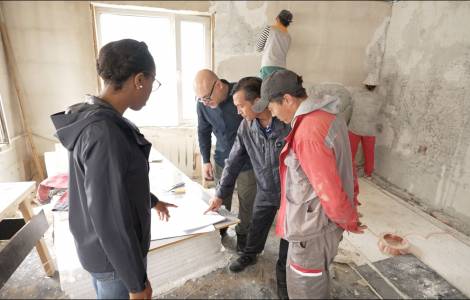
Ulaanbataar (Agenzia Fides) - The appointment is sscheduled for Monday, September 4: at 9.30 a.m. Pope Francis will meet with the workers of charity in the last public event of his apostolic journey in Mongolia before the farewell ceremony and in this context - as stated in the official program of the papal visit - will inaugurate the "House of Mercy". An eloquent conclusion to the journey: the building that the Pope will inaugurate can be considered a symbol of the charity that drives and animates the presence and life of the small Catholic community in Mongolia: the Church is at the service and for the good of all, starting with the weakest. While work is in progress to complete the building in view of the inauguration, the project also contributes to the realization of missionary collaboration in favor of the proclamation of the Gospel and the support of works of charity. The House of Mercy to be inaugurated by Pope Francis took shape thanks to the intuition of local Church leaders and was also supported by the concrete help of the National Direction of the Australian Pontifical Mission Societies, known as the Catholic Mission.
The project was launched in 2019: at that time, the Apostolic Prefect of Ulaanbataar (and current Cardinal) Giorgio Marengo, also in consultation with the missionaries, had the idea of opening a social center that would take care of women and minors who are victims of domestic violence. Since then, the project has continued to develop and become a reality: the "House of Mercy" sees itself as a place where people with problems and attention can find comfort and peace. The nascent House of Mercy is located in a disused school complex formerly owned by the Sisters of Saint Paul de Chartres, in the Bayangol district. The building has three floors and a basement and will serve not only as a temporary shelter for women and minors who have had to flee their homes after suffering abuse, but also as a first-aid facility where the homeless will receive medical care. Most homeless people are not registered with the national health system and therefore do not have access to treatment in public health facilities. The staff and volunteers also want to promote the re-establishment of contacts between the homeless and their families of origin in order to initiate family reunification processes. In addition, the House of Mercy is also intended to act as a temporary accommodation for migrants who arrive in the city and have no local reference persons (relatives, friends) who can provide them with initial support.
The operators of the House of Mercy will work together with the local police, social workers and the district's health facilities. In recent days, a delegation from the Pontifical Mission Societies of Australia visited Ulaanbataar and compiled a report full of data that helps to understand how the services offered by the House of Mercy will respond to emergencies and problems affecting the daily threaten the lives of the local population. The Bayangol district - according to the report prepared by Catholic Mission and available to Fides - is one of the nine districts in Ulaanbaatar and is located in the central part of the city and has a population of over 150,000 people. The district is known for its diverse social and economic background and is home to a mix of urban and rural communities with many residents engaged in both traditional and modern ways of life. Bayangol is a popular destination for immigrants from rural areas of Mongolia, who are drawn to the opportunities and amenities of the city. In terms of housing, Bayangol district is known for its mix of apartment buildings, traditional gers (Yurts), and single-family homes, the district has a range of housing options to suit different income levels, from affordable apartment buildings to upscale housing developments. In the Bayangol district, as in the rest of Mongolia, the wealth gap between rich and poor in Mongolia has widened in recent years. This inequality is reflected in a range of socioeconomic indicators, including access to education, healthcare, and other basic services.
The health system - reads the report - has been improving in recent years. The government provides free healthcare services to all citizens. However, the healthcare system still faces challenges such as a shortage of healthcare professionals and limited resources in some areas. Homelessness is a complex issue in Ulaanbaatar, and Bayangol District is no exception. According to some estimates, there are several thousand homeless people living in the city (at least 7 thousand). According to the National Statistics Office of Mongolia, as of 2021, the poverty rate in Ulaanbaatar was 27.4%, and the unemployment rate was 9.6%. The study found that the average concentration of particulate matter (PM2.5) was more than three times the World Health Organization. (GV) (Agenzia Fides, 12/7/2023)